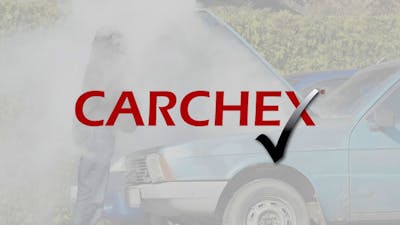Most Common Causes of a Car That Stalls
One of the most frustrating automotive issues to have is a vehicle that stalls. After all, if it was just running fine a moment ago, why stall now!? We can help you understand why a car might stall. Before we begin, let’s limit this discussion to cars that are underway and exclude one big reason cars stall - You are in a car with an old-school manual transmission, and the driver does not know how to operate it. Manual transmission is often referred to in our business as a 'millennial anti-theft device.'
Popular Warranty Providers
The most common stalling issues break down neatly into four categories. These are:
- Fuel issues
- Air issues
- Ignition and electrical issues
- Something crazy and very bad has occurred
Our instincts are to jump right to number four. Resist that urge to borrow worry from the future. For all you know, it is something straightforward and very easy to remedy. Let us mix up the categories a bit and do a top-down listing for you of the most common causes overall, and then we will dive into the four categories individually.
Safety First - What Should I Do If My Car Stalls?
Safety should be your first and only priority if a car you are driving begins to stall. Here is our list of suggestions when dealing with a stalling car.
- If your car begins to stall, immediately put on your hazard flashers. The button is mandated by law to be a red triangle in the middle of your dash. This is your best chance to alert other drivers that you are in a situation that could cause a safety risk.
- Steer the car to the right side of whatever road you are on using your turn signal. If that is not an option, for example, in slow-moving traffic, and you are in the far left lane, try for the side of the road, particularly if there is a median or a safety lane on the left of the travel lanes.
- If your car seems to have trouble moving due to a transmission issue or an engine issue, try neutral. Every car has a neutral setting. It may give you enough glide time to steer to a safer spot on the road.
- If the stalling is intermittent, meaning the car is sputtering but still has minimal power, steer to the safest available spot ahead. If a parking lot is available, take the gift. If you are on the highway and an exit is an option, take it. Finally, if on the highway and you see a spot in a breakdown lane where you can get over to the right to allow some added space between traffic and where you will end up parked, take that spot.
- If the worst happens and you are stalled on a busy highway in a middle travel lane, keep your seatbelt on and call 911. Exiting the vehicle in this instance is extremely dangerous and can be fatal.
- If you have stalled in the far right or far left lane, and there is a guard rail over which you could step to be out of traffic, take your phone and all of your warm clothes. Exit out the door closest to safety. Move to your safest available option and phone 911 first. They will tell you what to do next.
- If you have a pet in the vehicle, leave the pet inside. You may lose control of the pet and put its safety in jeopardy, but worse, the pet could become scared and dart away from you, causing an accident.
- Your best judgment as to how to keep any other occupants safe will be your guide, but always keep seatbelts fastened when inside a vehicle. Keep the hazard lights on at all times.
- Be aware that a car that starts to stall may have only moments of power steering and full braking power remaining. Do not hesitate to put yourself in the safest possible spot on the road. Flashers on. Look around you. Steer to your safest option and stop.
One last tip: If you ever find yourself in a stalled or vehicle emergency situation parked in relative safety and plan to exit the vehicle for any reason, roll down the passenger window before you get out. The reason is that if you exit and close the door, you could become locked out of your car. Having the passenger window rolled down will allow you to reach in and mechanically unlock the door, if need be, to re-enter. Why the passenger side? Because the window may not go back up, and if it rains, your driver’s seat won't get wet.
Reasons Why Your Car May Stall
Listed From Most to Least Likely
- You are out of fuel.
- Your battery has died (but why?).
- Your alternator has failed.
- Your car isn’t getting air properly (engine air filter?).
- Your car has a timing-related issue, perhaps a cam sensor or crank sensor failure.
- You have a problem with the actual engine or transmission.
Fuel-Related Stalling
It may seem obvious, but a car without any fuel in the tank, or battery, if it is an EV, will not continue running. Step back from the obvious, and the issue is not so simple. Perhaps the fuel gauge is faulty and reading above empty but is actually empty? Perhaps you were surprised by the stalling because you put in enough fuel, but it leaked out quickly? An empty fuel tank or empty EV battery is usually easy to resolve.
A vehicle that is not having its fuel properly delivered to the engine is also a common cause of stalling. The fuel may not be reaching the intake manifold for a number of reasons. Maybe you have a fuel filter that did its job and got clogged up with contamination. Or perhaps you are one of the many with a failed Denso fuel pump. There is a massive fuel pump recall campaign underway affecting many brands and models.
Liquid contamination of fuel can also occur. Did you just fill up? Maybe you accidentally input the wrong fuel by choosing the wrong handle, or the fuel you pumped was itself wrong in the underground tank. Or perhaps it was contaminated with water. The Car Talk Community gets a LOT of posts from folks who accidentally pumped diesel into their gasoline-powered car.
Air-Related Stalling
The flow of air into your vehicle and the exhaust out of the vehicle must be properly tuned and balanced to keep the engine running properly. If this happy dance of goez-intah and goez-outah of air isn’t just right, your car can stall.
Your exhaust gas recirculation valve (EGR Valve) or your oxygen sensor may have failed. These usually throw a pretty easy-to-identify engine code. That makes the diagnosis easy for your mechanic, and the remedy is not very expensive.
Your car breathes in air through an intake manifold and an engine air filter. If something gets into that area, perhaps a bit of road trash, a stall might occur. A dirty air filter won’t normally cause a stall. However, one packed with a rodent’s nest might. From the intake manifold, your engine’s incoming air heads to the throttle body area. A failure here can cause stalling.
Ignition and Electrical Related Stalling One of the very first things to have checked if your car stalls is the battery cable. Make sure this cable is properly connected and not corroded. You are not going to want to grab it with a hand decorated with a lot of rings. Don't grab it at all. In fact, let your AAA technician do that for you.
From here, things get a little more complex. Alternators cause cars to stall out when they die. And a whole long list of electrical things can stop working and make your car stall. It is best to ask a mechanic to look for the root cause, even if a jump start revives your car. This is likely to be a very temporary fix.
There are two common culprits related to electric stalling. They are the camshaft and crankshaft position sensors. These are important, and they come up with regularity in our Car Talk Community discussions. Here’s a full overview of camshaft and crankshaft position sensors.
One last electrical failure is a battery and alternator issue caused by a failed accessory belt. If the belt that drives the alternator breaks, your car will run out of electricity pretty quickly. This is one of the least expensive fixes, but you will need a tow. Replacing a belt at the side of the road isn’t practical.
Something Very Bad Happened Stalling
Most of the problems related to stalling are not very hard to diagnose, and they are not very expensive to remedy. The chances are your car has a problem that your mechanic will quickly diagnose and affordably repair. However, bad things do sometimes happen. Timing belts can break. Internal engine components can fail, and transmissions can go to transmission heaven. Your mechanic can tell you if one of these rare failures has occurred, but don't assume the worst.
Can I Fix My Car If It Stalls?
Many, if not most, of the problems that cause a car to stall are fixable by a shade tree mechanic. Given the right tools, some time, a youtube video, and access to a parts counter, a handy person can certainly do many of the things your mechanic will end up doing. However, diagnosis can take time, and a scan too. Without a running car, getting the parts you need is tricky and time-consuming.
Who Can Fix My Car That Stalls?
If your car stalls, the first available opportunity for a fix is your roadside assistance technician. She can use tools she has in her vehicle to diagnose simple problems like a loose battery connection or an alternator issue. She can visually check for a broken accessory belt. If there is any possibility you are out of fuel, she may be able to add a half gallon to see if that gets you back on the road.
Following an unsuccessful quick check by AAA or your roadside assistance provider, you will need a mechanic’s help. Your dealer will absolutely be able to resolve any issue. However, dealers have high overhead and high margin goals. In other words, they are pricey. A repair chain may be helpful, but it may not be. It depends entirely on the skills of the technician or mechanic at that chain that day. We prefer a trusted and experienced local mechanic.
What To Do If the Vehicle Restarts
If your car stalls or starts to stall and you pull over to safety, there is a chance the issue will resolve. Your temptation will be to resume your trip. Resist that temptation if you are headed back to a highway. If you are in town, drive to the nearest available service center, mechanic, or any car dealership of any brand. You may need help, and it is always better to be in the parking lot of a place that can fix a car.
If you are a few blocks from home, you can drive slowly there with flashers on. At the first hint of braking or steering trouble, stop and phone roadside assistance.
If you are stopped on the highway in a safe location, don't move. If you are able to see a safer spot ahead or an exit ramp, it will be a judgment call, but do not pull out into fast-moving traffic under any circumstances.
Common Causes of a Vehicle That Stalls Summary
Most of the reasons that car stalls are easy to diagnose and not very expensive to remedy. If you are in a vehicle that is stalling, safety is your first priority. Roadside assistance may get you back on the road, and if not, a trusted local mechanic is your best bet for an affordable repair.
Read more on the topic of Owning a Car here.













